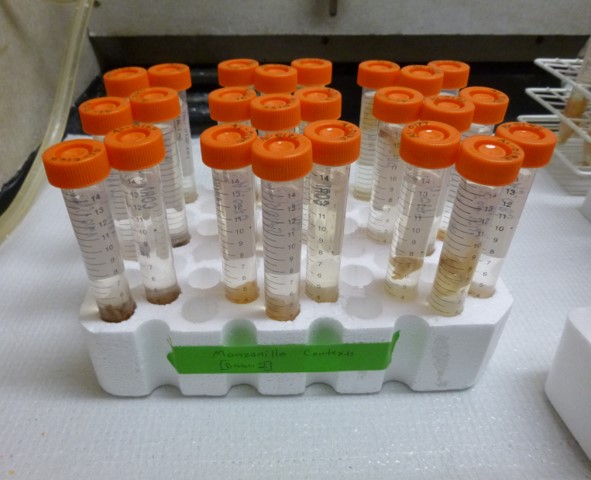Methods
Summary
RECONSTRUCTING DIET
For each burial, stable isotope ratios of carbon and nitrogen will be analyzed in a small sample of bone to reconstruct past dietary behaviors. Generally, stable carbon isotope values in human tissue reflect the types of plants eaten in life while nitrogen isotope ratios reflect the primary protein source in the diet.
Collagen preparation will follow procedures similar to those of the whole-bone method described by Sealy et al. (2014) in the Paleodiet Laboratory in at the University of California, San Diego. Bone samples will be demineralized for several weeks with 0.25M hydrochloric acid (HCl), changing the acid approximately every other day. After rinsing the demineralized five times with double-distilled water (H2O), humic acids will be removed by a 24 hour treatment with 0.125M sodium hydroxide (NaOH). Samples will then be rinsed five more times with double distilled H2O. Collagen gelatin samples willl next be solubilized in in pH 3 HCl at 75°C, frozen, and then lyophilized for 24 hours in a benchtop freeze dryer.
To measure stable isotope ratios of carbon and nitrogen, freeze dried collagen samples will be combusted into CO2 and N2 gas and analyzed by mass spectrometry at the Scripps Institute for Oceanography’s Analytical Facility using a Costech 4010 Elemental Analyzer coupled to the Thermo-Finnigan Delta XP Plus mass spectrometer. Carbon isotope ratios will be presented relative to the VPDB international standard and nitrogen isotope ratios relative to atmospheric δ15N (AIR). Replicates of an internal calibrated glycine standard will measure instrument stability and reproducibility for both δ13C and δ15N values. For all samples, diagenesis of collagen will be assessed through C:N ratios and percent of collagen yield, with acceptable ranges of 2.9-3.6 (DeNiro 1985) and >1% (Ambrose 1990), respectively.

REFERENCES
Ambrose, S. H. (1990). "Preparation and characterization of bone and tooth collagen for isotopic analysis." Journal of Archaeological Science 17(4): 431-451.
DeNiro, M. J. (1985). "Postmortem preservation and alteration of in vivo bone collagen isotope ratios in relation to palaeodietary reconstruction." Nature 317(6040): 806-809.
Sealy, J., et al. (2014). "Comparison of two methods of extracting bone collagen for stable carbon and nitrogen isotope analysis: comparing whole bone demineralization with gelatinization and ultrafiltration." Journal of Archaeological Science 47: 64-69.
ASSESSING RELATIVE HEALTH
For skeletal material recovered from Teul and Las Ventanas, analysis will occur in the field laboratory owned by the Mexican National Institute for Anthropology and History, directed by Laura Solar and Peter Jimenez. Each burial will be assessed for pathological conditions on the skeletons, such as evidence for systemic stress to the body (e.g. porotic hyperostosis, enamel hypoplasias, and bone infections), stature (a general indicator of nutritional health), trauma (broken and healed bones), and oral health (number of carious and missing teeth) (e.g. Buikstra and Ubelaker 1994). These analyses will be conduced in the archaeological laboratory in southern Zacatecas using a bright light and a hand-held magnifier glass.
REFERENCES
Buikstra, J. and D. H. Ubelaker (1994). Standards for Data Collection from Human Skeletal Remains. Fayetteville, Arkansas Archaeological Survey, Research Series No. 44.
QUANTIFYING INEQUALITY
The relative status of the burials will be assessed by counting the number of grave goods, accounting for their quality, and assessing the size, quality, and labor of their tombs. Quantitative assessments of inequality at the site will be based on grave lot values, Lorenz curves, and Gini indexes (e.g. Ames 2008). Comparisons will be made within Teul and Las Ventanas over time, between both sites, and to data from previously-studied populations.
REFERENCES
Ames, K., 2008. The archaeology of rank. Handbook of archaeological theories, pp. 487-513.
Protocols
This project has not yet shared any protocols.